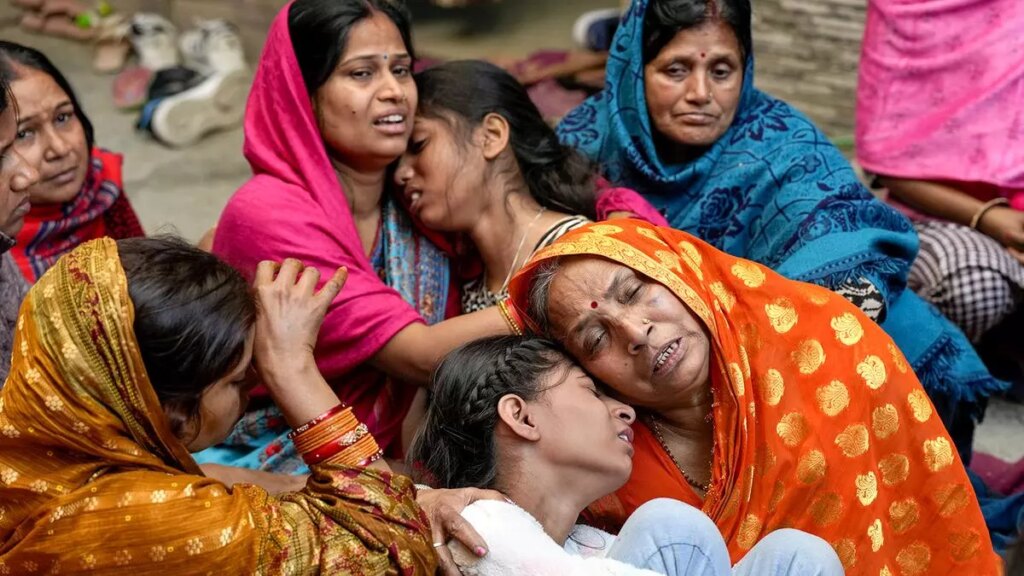
Relatives of Pinky Devi, 38, who died at the New Delhi Railway Station stampede. At least 18 people were killed and more than a dozen injured in the crowd rush, in New Delhi on February 15.
| Photo Credit: PTI
A confluence of poor railway safety measures and a frenzy of devotees rushing to board a special train heading to Prayagraj for the Maha Kumbh Mela on February 15, resulted in the death of 18 people, mostly women.
The 45-day event, projected as the world’s biggest religious congregation, began on January 13 and will conclude on February 26. The New Delhi Railway Station (NDLS) tragedy is the second deadly stampede connected to the Kumbh Mela, the first being at the Sangam in Prayagraj on January 29, which claimed 30 lives.
Several videos have surfaced on social media showing frustrated travellers, unable to board overcrowded trains at northern Indian railway stations, even shattering windows. What compounded the chaos at NDLS was the delay in three of the four Prayagraj-bound trains; this resulted in an unexpected overcrowding at the stations, according to officials. The Delhi Police added that the stampede was also triggered by confusion over announcements about two trains with similar names: the Prayagraj Special arriving at platform 16 confused passengers, as the Prayagraj Express was already stationed at platform 14.
Also Read | Mela for politics
When Frontline visited the station the day after the tragedy, platform 15 was a picture of grief, with a heavy police presence. Vendors and porters were visibly distraught from the horror they had witnessed. “I have been working here for nearly 25 years, but have never seen anything like this before during the Kumbh Mela,” said Lakhanlal Meena, a porter, recalling the crowd swell on platforms 14 and 15.
Other porters Sukesh and Balbir added: “The entire crowd started moving from platform 13 when an announcement about a sudden platform change was made. They used the footbridge, and that’s where the stampede happened.”
There was no security personnel or government staff in sight, recalled the porters. They transported the dead and injured on their hand-pulled wooden carts. “An official came 40-45 minutes after the incident. Porters and the vendors were the ones who saved lives,” said Balbir. “We pulled out the women and children who had been trampled upon. We called the ambulance.”
During festivals such as the Chhath Puja or Diwali, crowds at railway stations are usually managed with 30-40 personnel from the Railway Protection Force (RPF) and the Government Railway Police per platform. “But when the stampede occurred, there were only two,” observed a vendor who did not wish to disclose his name. “During Chhath, additional battalions are deployed, and rope dividers are used for orderly boarding. This time, there were no such arrangements.”
The victims of the Delhi station stampede were brought to Lok Nayak Jai Prakash (LNJP) Hospital, which was heavily barricaded, preventing media access. “Due to government restrictions, we are not permitted to speak to the media,” a supervisory doctor at LNJP told Frontline.
Yogi Adityanath’s government has been under intense public scrutiny for allegedly downplaying the real death toll of the pre-dawn stampede in Prayagraj on January 29. Multiple media reports have contradicted official claims, suggesting that the government failed to disclose a second stampede that occurred later on the same day, just kilometers from the Sangam nose point.
Also Read | A dip in politics at the Mahakumbh
Adityanath has been facing severe criticism from several quarters. He had expected 40 crore devotees ahead of the Mela, claiming that his government had made arrangements to accommodate over 100 crore people. Samajwadi Party chief Akhilesh Yadav claimed the Adityanath government has downplayed the total daily footfall in the city “because when international media or academic institutions later evaluate the administration and management of this event, they will find it was not handled properly given the actual number of attendees”.
Swami Avimukteshwaranand Saraswati of Joshimath too criticised Adityanath for his “misleading” remarks following the Prayagraj stampede and for the VIP culture at the Mela site.
The Opposition has attacked the BJP for the Delhi tragedy. The general secretary of the All India Congress Committee, Randeep Singh Surjewala said the Railways Minister, Ashwini Vaishnaw, who spoke of “world-class arrangements”, should resign.
The small city of Prayagraj has been overwhelmed by an unprecedented influx of crowds, straining its already limited civic infrastructure. Despite initial vociferous demands from certain babas and Hindutva activists to bar Muslims from entering the Mela area, local Muslims have been welcoming devotees into their homes and shrines, offering hospitality and support.
Meanwhile, the Ministry of Railways has constituted a two-member inquiry committee to investigate the stampede at NDLS. While the families of the deceased in Prayagraj were given a financial compensation of Rs.20 lakh, the Indian Railways announced a compensation of Rs.10 lakh for the bereaved families of the NDLS stampede.
Investigators probing the January 29 Prayagraj stampede have now begun looking at a possible conspiracy, analysing data from over 16,000 mobile numbers active in the Sangam nose area, the stampede’s epicenter, on the day of the incident.
Source:https://frontline.thehindu.com/news/new-delhi-railway-station-stampede-kumbh-mela-2025/article69228901.ece

